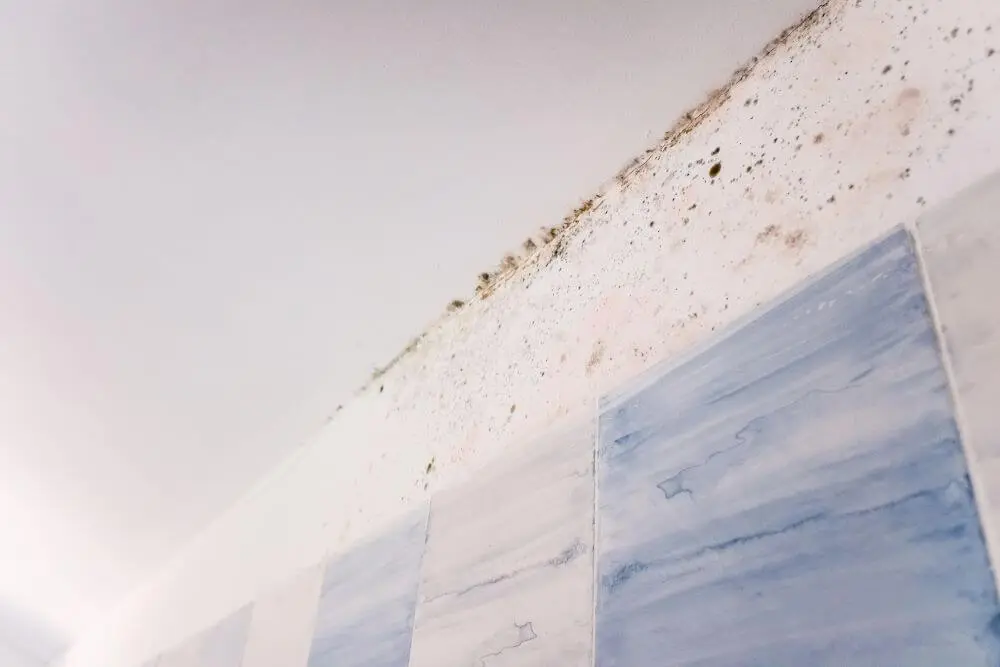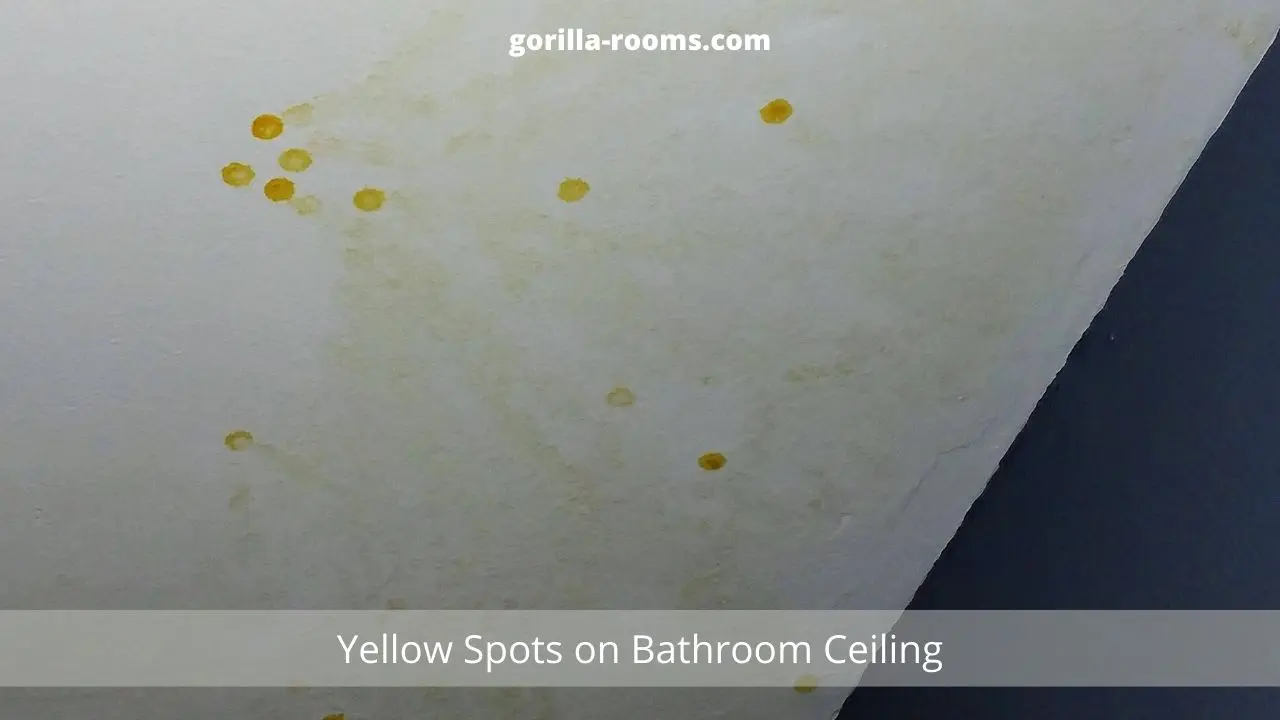Over time, Bathroom ceilings are likely to turn a yellow or brownish tone, which is a sign of water damage. Poor ventilation is a common sign of yellow spots on the Bathroom ceiling. In addition, heat discharge from heating appliances like the water heater in the bathroom can cause yellow spots.
If you’ve been noticing yellow sticky spots on the ceiling, don’t worry. They’re not a sign of mold – they’re a sign of water damage.
As harsh as it sounds, water eventually finds its way up to the highest points in your home, where it speaks out for all to see. So the best thing to do is to act before the problem gets worse and starts spreading throughout your home.
How To Stop Yellow Spot Damage On Bathroom Ceiling?

First, turn off the water supply to your bath or shower. Then, use a sponge or cloth to wipe the ceiling and walls. Allow them to dry completely before you have any other water running in your bathroom. Next, remove the grout or caulk that keeps the tile or liner around your showerhead.
You’ll find rust-colored water stains discolor it if you put some force into the peeling process; this is normal and indicates that you need to replace those tiles.
The best way to replace them is by using a “ceiling liner,” which is easier to hang up tiles above than below your bathroom ceiling. This liner will also prevent water from dripping down through the tiles behind your showerhead and causing further damage.
To install the liner, use an adhesive to glue it to your ceiling. Then, pile up some old magazines or newspapers around the showerhead and use a hammer to tap in plastic anchors for either side of the showerhead and connect them with string.
Lastly, replace any caulk that you’ve previously removed along the edges of your tub. If you can’t find a color match for your old caulk, go ahead and buy a new caulk in a similar color; it’s better than living with rust-colored stains on your bathroom ceiling.
How To Clean Yellow Spots On Bathroom Ceiling?
Yellow sticky spots on the ceiling can be cleaned in several ways. Here are a few DIY ways that you can try to clean bathroom ceilings.
- Rinse the affected area with water and dry it.
- Use a mild soap to scrub the surface you want to clean. Do not use harsh chemicals, solvents, or bleach since they could damage the surface of your ceiling if not diluted properly.
- Apply a cleaning product specifically designed for waterproof ceilings containing mild water. Make sure you follow all manufacturer instructions on the container.
- Use a dry, clean cloth to wipe dry the excess cleaning product.
How To Clean Yellow Stain On Bathroom Ceiling With Chemicals?

It’s essential to clean the ceiling stains right away because they can turn into black mold if left for too long. You can use any of these solutions below:
- Clean with ammonia mixed with water and detergent mixed with water in equal parts, using a sponge or cloth to wipe gently over the stained area; rinse with clear warm water to remove remaining traces of ammonia from the surface.
- You can also use commercial bathroom cleansers to clean the yellow stains from your bathroom ceiling. Cleaners specifically for cleaning dirt on the ceiling will give you better results than using an all-purpose cleaner mixed with ammonia or detergent.
- Spread out a thick layer of baking soda on the stained area, let it sit for at least 30 minutes so that the baking soda can absorb the yellow sticky spots on the ceiling, and use a sponge or cloth to wipe off.
Main Causes Of Yellow Stain Bathroom Ceiling
1- Insecticide
An insecticide used in the home might cause yellow spots on the bathroom ceiling. It is best to clean off these insects and their droppings without powder or spray to avoid this.
2- Mold
Mold growth can often produce yellowish stains on surfaces such as shower cabinets and walls. If your home contains a lot of moisture, mold may be more likely to grow in areas that don’t get much light or air circulation.
The bathroom, for example, is a prime breeding ground for mold. If your bathroom is always wet or humid and you don’t use your fan often enough, you may find yourself with yellow spots on the ceiling.
3- Old House Paint
Old house paint can sometimes produce yellow spots on the bathroom ceiling. When old paint undergoes moisture-related damage, it can release toxic chemicals to humans.
4- Aging Wall
Yellow sticky spots can also form when a wall absorbs too much moisture over time and starts to break down. Attics and bathrooms are particularly susceptible to this type of damage because they contain large amounts of insulation and thus retain more moisture than other home areas.
5- Cleaning Products
Cleaning products such as bleach can also create yellow spots on the bathroom ceiling. To avoid this, use a milder cleaning solution or remove any cleaning chemicals from the room before you leave your home.
6- Plumbing Leak
Sometimes, plumbing leaks can cause yellow sticky spots on the bathroom ceiling, especially if the leak was in a very old part of your home’s plumbing system. In many cases, these leaks are minor enough that you may not even notice them because they’re under a sink or behind a toilet.
7- Bathroom Exhaust Fan
A dirty bathroom exhaust fan can cause yellow spots on the bathroom ceiling, especially in older homes. When your home’s exhaust fan is dirty or covered with dust, it won’t be able to pull moisture out of the air as well.
This may cause substantial damage to your home, especially if you live in an old house or your bathroom is near a wet area such as a kitchen or laundry room.
The following factors can also contribute to your yellow spots on the bathroom ceiling:
- Possible leak highlights
- Faucet leaks
- Leaking pipe or water heater
- Dirty water inside the tank, dirty seal, and leaky rubber washers
How To Avoid Yellow Stain In Bathroom?
Calcium deposits and hard water come with large amounts of alkalinity, which reacts with natural organic compounds in the air to form insoluble limescale deposits against surfaces such as baths, showers, and sinks, which eventually makes yellow spots on bathroom ceilings.
Moreover, Clogs in your drain pipes can also allow air bubbles to escape through the sink’s overflow valve and reach the plumbing stack.
This escape of air bubbles will disturb the standing water in your toilet tank or bowl, which will cause it to react with oxygen in the atmosphere and turn a bright shade of yellow.
Calcium deposits and hard water come with large amounts of alkalinity, which reacts with natural organic compounds in the air to form insoluble limescale deposits against surfaces such as baths, showers, and sinks, which eventually makes yellow spots on bathroom ceilings.
Moreover, Clogs in your drain pipes can also allow air bubbles to escape through the sink’s overflow valve and reach the plumbing stack.
This escape of air bubbles will disturb the standing water in your toilet tank or bowl, which will cause it to react with oxygen in the atmosphere and turn a bright shade of yellow.
The best way to avoid these yellow stains is to paint your ceiling with non-yellowing paint. However, if you are looking for a cheap and easy way to remove the yellow spots on your ceiling, try baking soda.
The baking soda will absorb the sulfuric acid and will neutralize it. Then you can scrub it with a rag and ammonia-free soap.
If you don’t have time or money to paint your entire bathroom or other home surfaces, then use some everyday household items available almost anywhere. For example, if sulfuric acid comes out of the shower or bathtub faucet, cover the opening with duct tape and a cloth.
Is Yellow Stain On Bathroom Ceiling Dangerous?
There is no need to panic if you have yellowish stains on your ceiling because they may be coming from the toilet overflow, mold, or regular water pipe leakage.
But moisture can lead to mold growth, resulting in serious health risks, so any moisture problem must be dealt with as soon as possible. It may seem that this problem is minor, but it can lead to more significant problems. Sometimes the first sign of indoor mold growth is an annoying toilet overflow.
Thus, it is important to fix this as soon as possible. This can be done by following some simple steps, and you should be able to tackle the problem by yourself. Let us look at how we can do this and stop the bathroom ceiling from getting any more yellow.
Frequently Asked Question (FAQ)
What Are These Yellow Stains?
The most common cause is a leaked toilet tank with a poorly designed overflow pipe that lets water drip down onto the ceiling directly above. Often these leaks can go unnoticed for months before they finally show up, which is why this type of stain on your bathroom ceiling can be so jarring and hard to clean up.
Why Do They Look Like Little Droppings?
These yellow stains on bathroom ceilings look like little droppings because they are deposits of minerals that have seeped out of the water and dried up.
Also, the minerals will naturally cling to a vertical surface, so they collect directly above where the leak is coming from.
How Do I Know If It’s A Leak Or Just Paint Or Something Else?
If you have a water leak problem or some other fault in your bathroom ceiling, you can use this simple test: Fill up your bathtub with about 4 inches of water. If you cannot fill it without leaking, the problem is most likely in your ceiling.
Final Verdict
Yellow sticky spots on the bathroom ceiling are a big problem that you can’t ignore. The leading causes are mold, water leakage, and many other reasons. Still, there are many DIY solutions that you can try to remove yellow spots on bathroom ceilings.
We hope this information has been helpful and will help keep you from dealing with those unsightly yellow stains on your bathroom ceiling.
Related Posts:

